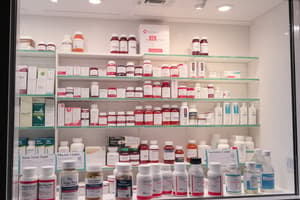Podcast
Questions and Answers
What are the three primary assessments conducted in the Core Battery of safety pharmacology?
What are the three primary assessments conducted in the Core Battery of safety pharmacology?
Cardiovascular assessment, CNS assessment, and Respiratory assessment.
Identify two CNS adverse drug reactions (ADRs) that may significantly impact a patient's quality of life.
Identify two CNS adverse drug reactions (ADRs) that may significantly impact a patient's quality of life.
Anxiety and cognitive impairment.
Which life-threatening CNS ADR is associated with decreased respiratory drive?
Which life-threatening CNS ADR is associated with decreased respiratory drive?
Respiratory arrest.
Mention one indirect life-threatening CNS ADR and explain its potential consequences.
Mention one indirect life-threatening CNS ADR and explain its potential consequences.
What physiological assessments are used to study ADRs in the nervous system?
What physiological assessments are used to study ADRs in the nervous system?
List two symptoms that reflect cognitive disturbances as CNS ADRs.
List two symptoms that reflect cognitive disturbances as CNS ADRs.
What is a common ADR that can occur due to psychotropic medications and impact motor skills?
What is a common ADR that can occur due to psychotropic medications and impact motor skills?
Describe the relationship between CNS ADRs and quality of life as stated in the document.
Describe the relationship between CNS ADRs and quality of life as stated in the document.
What is the primary purpose of safety pharmacology in drug development?
What is the primary purpose of safety pharmacology in drug development?
Define 'Type A' adverse drug reactions and provide an example.
Define 'Type A' adverse drug reactions and provide an example.
How do industry and regulators collaborate to minimize adverse drug reactions?
How do industry and regulators collaborate to minimize adverse drug reactions?
What is the purpose of the 'core battery' in safety pharmacology?
What is the purpose of the 'core battery' in safety pharmacology?
What factors may lead to the decision to conduct follow-up studies after initial testing?
What factors may lead to the decision to conduct follow-up studies after initial testing?
What criteria are used to decide the progression to First in Human (FIH) studies?
What criteria are used to decide the progression to First in Human (FIH) studies?
What does 'attrition' in drug development refer to?
What does 'attrition' in drug development refer to?
Why is it important to conduct regulatory studies during drug development?
Why is it important to conduct regulatory studies during drug development?
What is meant by 'frontloading' in the context of drug discovery?
What is meant by 'frontloading' in the context of drug discovery?
What are some of the main reasons for drug failure in late stages of development?
What are some of the main reasons for drug failure in late stages of development?
List at least two types of regulatory toxicology studies required in drug development.
List at least two types of regulatory toxicology studies required in drug development.
How has the main reason for drug failure evolved over time?
How has the main reason for drug failure evolved over time?
What is the significance of target validation in drug discovery?
What is the significance of target validation in drug discovery?
Identify one type of safety pharmacology study associated with regulatory requirements.
Identify one type of safety pharmacology study associated with regulatory requirements.
What factors determine the therapeutic window of a drug?
What factors determine the therapeutic window of a drug?
How does the lethality of a target disease influence the therapeutic window?
How does the lethality of a target disease influence the therapeutic window?
In cases of non-lethal diseases, how are ADRs treated in the context of the therapeutic window?
In cases of non-lethal diseases, how are ADRs treated in the context of the therapeutic window?
What is the significance of the NOEL and NOAEL in the context of drug discovery?
What is the significance of the NOEL and NOAEL in the context of drug discovery?
What role does the maximum ‘safe’ concentration (MSC) play in assessing drug safety?
What role does the maximum ‘safe’ concentration (MSC) play in assessing drug safety?
Why might the therapeutic window be narrower for cancer treatments compared to other conditions?
Why might the therapeutic window be narrower for cancer treatments compared to other conditions?
How does pharmacokinetics influence whether a substance is classified as a drug?
How does pharmacokinetics influence whether a substance is classified as a drug?
What drug discovery focus arises from evaluating ADRs in relation to NOEL and NOAEL?
What drug discovery focus arises from evaluating ADRs in relation to NOEL and NOAEL?
What is the purpose of safety assessment in drug discovery?
What is the purpose of safety assessment in drug discovery?
How does high throughput screening (HTS) contribute to drug safety?
How does high throughput screening (HTS) contribute to drug safety?
What is meant by a 'toxic pharmacophore'?
What is meant by a 'toxic pharmacophore'?
Explain what constitutes a class effect in drug safety.
Explain what constitutes a class effect in drug safety.
What is a drug-drug interaction (DDI) and why is it significant?
What is a drug-drug interaction (DDI) and why is it significant?
How can supratherapeutic concentrations influence drug safety assessments?
How can supratherapeutic concentrations influence drug safety assessments?
What role do non-specific effects play in drug safety assessment?
What role do non-specific effects play in drug safety assessment?
Why is it important to consider drugs metabolized by the same pathways in safety assessments?
Why is it important to consider drugs metabolized by the same pathways in safety assessments?
Flashcards are hidden until you start studying
Study Notes
Therapeutic Window
- Defined by the NOEL (No Observed Effect Level) and NOAEL (No Observed Adverse Effect Level), with consideration for disease severity and ADR (Adverse Drug Reactions) severity.
- Target diseases that are lethal may allow for serious ADRs if benefits outweigh risks.
- For diseases like cancer, the therapeutic window is narrower, leading to a focus on drugs that cause lesser ADRs and higher NOAELs.
- Context plays a critical role; for non-lethal diseases, even minor ADRs can render a drug unusable.
Risk-Benefit Analysis
- Maximum Safe Concentration (MSC) is relative and determined through risk-benefit evaluations.
- Risks from ADRs are weighed against the therapeutic benefits provided by the drug.
Drug Development and Attrition
- Drug development involves numerous phases: Discovery, Pre-clinical, and Clinical Trials (Phases I-IV).
- Attrition occurs when drugs fail during development; historically attributed to poor pharmacokinetics and utility of the molecular target.
- Recent reasons for failure focus increasingly on ADRs, emphasizing the necessity for early detection in the discovery phase.
Frontloading in Safety Assessment
- Integrates target validation with safety assessment from the outset.
- Evaluates on-target effects from supratherapeutic doses and secondary ADRs.
- High Throughput Screening (HTS) is employed to identify potential risks and off-target effects early in development.
Safety Assessment Considerations
- Certain chemical structures are linked to specific ADRs, termed 'toxic pharmacophores.'
- A 'class effect' arises when drug effectiveness is contingent upon the presence of these toxic structures.
- Drug-drug interactions (DDI) can exacerbate ADRs; for example, cimetidine reduces the metabolism of theophylline by interfering with cytochrome P450.
Safety Pharmacology Core Battery
- Safety assessments focus on cardiovascular, CNS (Central Nervous System), and respiratory effects.
- CNS ADRs range from mild impacts on quality of life to severe life-threatening reactions, such as respiratory arrest or cardiovascular collapse.
- CNS ADR manifestations include lethargy, cognitive impairment, seizures, and various autonomic effects that could indirectly endanger life.
Approaches to ADR Studies
- In vitro methods include neuronal cultures, electrophysiology, and behavioral assessments.
- Adhering to ICH S7A/B guidelines helps scientists predict and manage ADRs effectively.
- Recent advances in testing have improved predictivity, reducing the risk of significant adverse effects in new drugs.
Learning Outcomes
- Understand the emergence and development of Safety Pharmacology.
- Differentiate between types of ADRs, including Type A and others.
- Recognize the collaborative efforts of the industry and regulators to mitigate ADR risks.
- Identify components of the safety pharmacology core battery and critical regulatory approval tests.
- Grasp the triggers for follow-up studies and criteria for initiating First-in-Human trials.
Studying That Suits You
Use AI to generate personalized quizzes and flashcards to suit your learning preferences.




